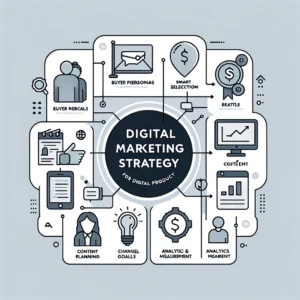Integration of business strategy assessment is not just beneficial but essential. This integration serves as a pivotal factor in steering product innovations toward market success and sustainability. Today’s global market is characterized by rapid technological advancements, evolving consumer preferences, and intensifying competition. These elements demand a strategic approach to product development that transcends conventional methodologies.
Business Strategy Assessment in Product Development encompasses a comprehensive evaluation of market conditions, consumer trends, organizational competencies, and technological feasibilities. It aligns these elements with the company’s strategic vision, ensuring that new products not only fulfill market needs but also reinforce the company’s competitive position. In this article, we delve into various facets of this subject, tailored for experts who seek to deepen their understanding and refine their approach to product development in a business context.
As we explore the evolving landscape of product development, the strategic imperatives, and the role of business analysis, we aim to provide a nuanced understanding of how effective business strategy assessment can act as a catalyst for innovation and growth. This article will serve as a comprehensive guide, offering insights, examples, and practical strategies for professionals navigating the complex yet rewarding journey of product development.
The Evolving Landscape of Product Development
In today’s rapidly expanding global marketplace, businesses face unprecedented challenges and opportunities in product development. The market dynamics are increasingly influenced by informed consumers who demand customizable products, focusing more on value than brand loyalty. This shift requires businesses to meet a diverse array of customer needs, adapting to various market segments across different regions, such as the growing middle classes in Asia and Latin America and niche segments in the United States and Europe.
Concurrently, product technologies are experiencing a state of convergence. Traditional boundaries between different technological domains are blurring, necessitating a broad spectrum of new skills. For instance, automotive OEMs now find themselves at the crossroads of mobile communications, battery technology, and software development. This convergence is not just a challenge but an opportunity for innovation and differentiation.
As market and technological landscapes continue to evolve at a relentless pace, many business leaders express concerns about their organization’s ability to adapt quickly enough. Some opt for creating start-ups outside their traditional structures or turn to outsourcing for agility and speed. Others attempt to reshape their existing organizations to meet these emerging challenges. However, overcoming these hurdles requires a strategic, well-structured approach, acknowledging the changing market dynamics and technological advancements.
This evolving landscape sets the stage for our discussion on the critical role of business strategy assessment in product development. Understanding and adapting to these changes is vital for businesses aiming to remain competitive and innovative in the current market scenario.
Strategic Imperatives for Product Development

In an era marked by rapid disruption and technological shifts, it is crucial for companies to steer clear of the fate that befell industries like film photography. This necessitates a strategic focus that aligns with how a company will compete in the future. A vital aspect of this strategy is defining the competencies and capabilities needed at different stages. This foresight is instrumental in building consensus around necessary investments and future competitive positioning.
Competencies, either ‘hard’ like predictive analytics and software development or ‘soft’ like decision making and talent management, form the backbone of an organization’s capability. When these competencies are synergistically combined, they foster capabilities that significantly contribute to customer value creation. These capabilities, being hard to replicate, offer a sustainable market differentiation and advantage.
Implementing a competency-driven approach in product development involves a structured, disciplined methodology. Companies need to pinpoint product development capabilities that set them apart in the market, like the ability to launch products rapidly or those with distinctive aesthetics and shelf presence.
This strategic focus on competencies and capabilities necessitates a comprehensive assessment of the organization’s current state and its alignment with future market needs. This alignment is key to ensuring that product development efforts are not only technically sound but also strategically relevant, paving the way for long-term business success.
The Competency-Driven Approach in Product Development
Transitioning product development functions to be more competency-driven involves a six-step process. This approach ensures that companies adopt a structured methodology, focusing on competencies that differentiate them in the market. These steps include:
- Identify Critical Competencies: This involves recognizing technology shifts and the competencies needed to address them. It requires an in-depth examination of the industry and markets, identifying competencies relevant in the near future, addressing both hard and soft competencies
- Rank Competencies: After identification, companies must prioritize competencies that support their specific strategy, brand, and customer value proposition. These should be rated against criteria like alignment with corporate strategy, importance in meeting customer requirements, impact on brand identity, and regulatory needs
- Assess Maturity: The third step is to assess the maturity of each competency within the product development functions. This involves a combination of hard data and qualitative assessments, including expert feedback and reviews by customers, suppliers, and internal stakeholders.
- Map Competencies: Companies then identify competencies to develop. Competency mapping plots each competency according to its strategic importance and maturity level, helping identify critical gaps and manage resources effectively
- Develop Unique Capabilities: Plan to combine strategically important competencies into unique capabilities that create sustainable market advantages. This may involve developing new competencies in-house or through partnerships
- Review Strategic Plans: Finally, companies must continually review and refresh strategic competencies and capabilities to keep pace with industry and market conditions.
This competency-driven approach is integral for organizations to effectively respond to rapidly changing market demands and technological advancements, ensuring that their product development strategies are both innovative and aligned with long-term business objectives.
Business Analysis: Cornerstone of Product Development
Business Analysis plays a critical role in the success of new product development initiatives. It methodically evaluates market conditions, customer preferences, and organizational capabilities, guiding the development of products that meet market needs and drive business growth. This analysis helps organizations understand the market landscape comprehensively, which is crucial in the context of new product development.
Moreover, Business Analysis allows organizations to assess the feasibility and viability of new product ideas, considering technical requirements, resource availability, and market potential. This strategic evaluation supports informed decision-making about resource allocation and investment, reducing the risk of developing non-viable products.
Furthermore, by conducting competitive analysis, organizations can identify key competitors, evaluate their product offerings, and pinpoint opportunities for differentiation. This understanding is critical for positioning new products effectively and developing unique value propositions that resonate with customers.
In essence, Business Analysis forms the backbone of new product development, providing valuable insights, facilitating informed decision-making, and ensuring that developed products align with customer needs and market demands.
Key Components of Business Analysis in Product Development
Business Analysis in new product development encompasses several crucial components, each playing a pivotal role in ensuring the success of the development process:
- Market Research: Gathering information on the target market, including customer preferences, market trends, competitors, and industry dynamics. This research lays the groundwork for understanding market needs and identifying new product development opportunities.
- Customer Analysis: Involves segmenting the target market, identifying customer personas, and conducting surveys or interviews to understand customer needs and preferences.
- Feasibility Assessment: Evaluating the technical feasibility, market potential, resource availability, and financial viability of new product ideas.
- Requirements Gathering: Defining clear product requirements by eliciting and documenting user requirements, business needs, and technical specifications.
- Competitive Analysis: Assessing the competitive landscape to differentiate the new product and develop a competitive advantage.
- Risk Analysis: Identifying potential risks and uncertainties that may impact the product’s success and developing risk mitigation strategies.
- Financial Analysis: Evaluating the economic viability and profitability of new product development through cost estimation, pricing strategies, revenue projections, and ROI analysis.
These components collectively ensure that the product development process is grounded in a thorough understanding of market dynamics, customer needs, and competitive pressures.
Implementing Business Analysis: A Step-by-Step Guide
To conduct effective Business Analysis in new product development, a systematic approach is essential. The steps include:
- Define Objectives: Clearly establish the goals of the Business Analysis process, such as understanding customer needs or assessing product feasibility.
- Gather Market Insights: Conduct comprehensive market research to understand customer preferences, trends, and the competitive landscape.
- Identify Customer Needs: Engage with customers to determine their requirements and preferences.
- Analyse Existing Solutions: Evaluate current market solutions to identify strengths, weaknesses, and differentiation opportunities.
- Define Product Requirements: Based on insights and customer needs, define specific product requirements and specifications.
- Assess Feasibility: Evaluate the feasibility of the new product in terms of resources, production capabilities, cost, and potential risks.
- Collaborate with Teams: Foster collaboration among cross-functional teams involved in the product development process.
- Document Findings and Recommendations: Clearly document the insights, recommendations, and strategies derived from the analysis.
- Iterate and Refine: Continuously update and refine the Business Analysis to adapt to market changes and evolving customer preferences.
This step-by-step guide ensures that Business Analysis is conducted in a structured manner, leading to informed decision-making and successful product development.
[H2] Bridging Strategy and Operation: The Role of Product Development Assessment
The Product Development Assessment serves as a high-level overview of a company’s product development process from a strategic and operational perspective. This assessment is crucial for companies striving to excel in product development, as it directly correlates with commanding higher margins and a competitive advantage.
Key aspects of this assessment include:
- Understanding the implementation of new products and services from ideation to production.
- Identifying key operational and strategic gaps against industry best practices.
- Defining measures and performance standards, and assessing conformity to established business processes.
- Evaluating product development management processes.
The deliverable of this assessment is a concise report identifying key process and capability gaps, providing a roadmap for improvements. This includes insights into current skills, technology gaps, and roadblocks to success.
This comprehensive assessment plays a critical role in ensuring the product development process is not only efficient but also strategically aligned with the company’s broader business goals.
Continuous Improvement and Adaptation in Product Development
For sustained success in product development, continuous improvement and adaptation are imperative. This involves strategies for ongoing refinement of processes and methodologies, adapting to changing market conditions and technological advancements. Successful companies consistently evolve their product development strategies, learning from real-time market feedback and technological trends.
This approach entails a relentless pursuit of innovation, efficient utilization of resources, and a keen focus on aligning product development with evolving customer needs and market opportunities. It demands a proactive stance in anticipating market shifts and a flexible approach to integrating new technologies and methodologies.
Through this lens of continuous improvement and adaptation, organizations can maintain relevance and competitiveness in the fast-paced landscape of product development, ultimately contributing to long-term business growth and profitability.




